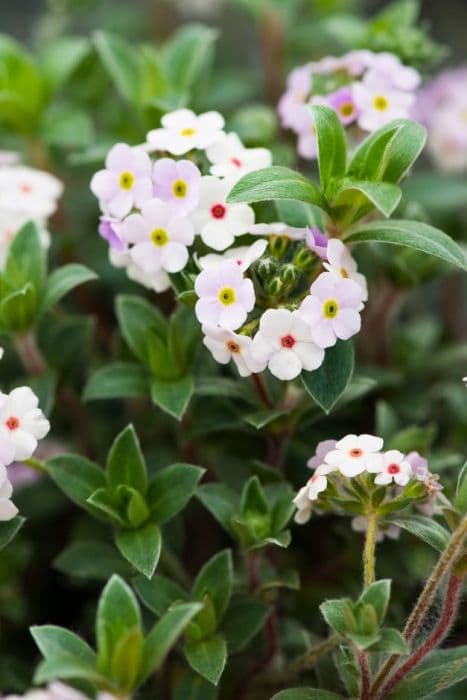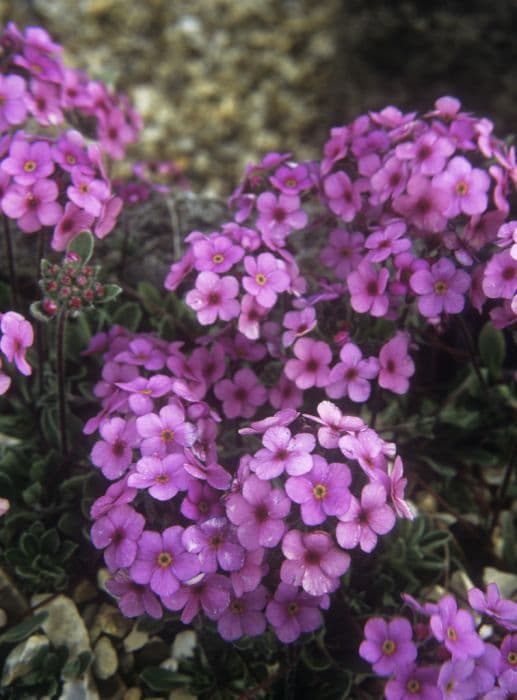Primrose Primula 'Tony' (Au)

ABOUT
Primula 'Tony' (Au) is a charming perennial plant known for its vibrant flowers and decorative foliage. It typically blooms in the springtime, displaying a lovely array of colors that can include shades of yellow, red, pink, blue, or purple. The flowers usually have a bright yellow center, which creates a beautiful contrast against the petals. The leaves of this Primula are generally oblong to oval in shape with a slightly toothed or crinkled edge, giving them a textured appearance. They are often deep green, which further accentuates the colorful blooms. The foliage forms a low-growing rosette, serving as a lush base for the flowers which rise above on slender stalks. The flowers themselves form in clusters at the top of these stems, with each individual bloom resembling a small cup or tube. The clustered nature of the flowers adds to the visual impact of the plant, making it a popular choice for gardeners looking to add a splash of color to their garden beds or borders. The overall appearance of Primula 'Tony' is one of cheerful brightness and springtime appeal, which can last well into the summer months depending on the climate and growing conditions.
About this plant
 Names
NamesFamily
Primulaceae
Synonyms
Tony Primrose
Common names
Primula 'Tony' (Au)
 Toxicity
ToxicityTo humans
Primula 'Tony' is a cultivar of the genus Primula, commonly known as primrose. Generally, primroses are not considered highly toxic to humans. However, some people may experience contact dermatitis when handling the plant due to the presence of primin, a compound found in the plant's sap. If ingested in large amounts, it may cause mild stomach upset, nausea, or vomiting. It is advisable to keep the plant out of reach of children, who might be tempted to eat the colorful flowers or leaves.
To pets
Primula 'Tony', commonly known as primrose, can be mildly toxic to pets. Ingestion of the plant parts, particularly in large amounts, may lead to gastrointestinal upset in animals such as cats and dogs. Symptoms of primrose poisoning in pets might include vomiting, diarrhea, and drooling. If you suspect your pet has ingested primrose, it is best to consult a veterinarian. While the toxicity is typically low, individual pets may have varying sensitivities, and it is better to err on the side of caution.
 Characteristics
CharacteristicsLife cycle
Perennials
Foliage type
Evergreen
Color of leaves
Green
Flower color
Varies
Height
6 inches (15 cm)
Spread
8 inches (20 cm)
Plant type
Herb
Hardiness zones
Varies
Native area
Varies
Benefits
 General Benefits
General Benefits- Easy to care for: Primulas are generally low-maintenance, making them suitable for gardeners of all skill levels.
- Colorful blooms: With vibrant flowers, Primulas add a splash of color to gardens and indoor spaces.
- Long flowering period: They have a prolonged blooming season, often from late winter to early spring.
- Attracts pollinators: The flowers of Primulas are known to attract bees and butterflies, promoting pollination in the garden.
- Versatile planting options: Primulas are suitable for borders, containers, and as part of rockeries or woodland gardens.
- Spring interest: Being one of the earliest flowers to bloom, they are ideal for bringing life to the garden after winter.
 Medical Properties
Medical PropertiesThis plant is not used for medical purposes.
 Air-purifying Qualities
Air-purifying QualitiesThis plant is not specifically known for air purifying qualities.
 Other Uses
Other Uses- Primulas like 'Tony' (Au) can be used in crafting and nature-inspired art, such as pressing the flowers for bookmarks or cards, adding a delicate and colorful touch to paper crafts.
- The vibrant flowers of Primula can be used as a natural dye for fabrics or Easter eggs, creating soft pastel hues in shades of yellow from the petals.
- In a sensory garden, Primulas are valuable for their diverse textures and fragrances, which can be appreciated by visually impaired individuals or for educational purposes.
- Primula flowers can be frozen in ice cubes to add a decorative flair to summer beverages, giving a unique touch to garden parties and events.
- Children's educational activities often include plant identification and nature exploration, where Primulas can be used to teach kids about flowering plants and seasonal changes.
- Floristry sometimes uses Primulas for their bright colors and compact shape, creating intricate living jewelry like flower crowns or bracelets.
- Primula plants can serve as natural indicators of the changing seasons, as they typically bloom in early spring and can be observed as part of phenology studies.
- Edible Primula flowers can be candied to create decorative cake toppings or to sweeten desserts, contributing both flavor and aesthetics.
- As a model organism in botanical studies, Primulas can be used for genetic research or studies on flower development due to their distinct morphology.
- Primula flowers can be used in homemade potpourri mixtures, contributing their subtle fragrance and color to the combination.
Interesting Facts
 Feng Shui
Feng ShuiThe Primrose is not used in Feng Shui practice.
 Zodiac Sign Compitability
Zodiac Sign CompitabilityThe Primrose is not used in astrology practice.
 Plant Symbolism
Plant Symbolism- Youth: The Primula, commonly known as Primrose, is often associated with the essence of youth due to its early spring blooming, symbolizing new life and beginnings.
- Hope: As one of the first flowers to bloom at the end of winter, the Primrose signifies hope and the anticipation of joys to come.
- Love: In Victorian times, Primroses were given as a symbol of young love and affection.
- Renewal: The Primrose's habit of returning each year with bright flowers is symbolic of renewal and the cycle of life.
 Water
WaterPrimulas, commonly called Primrose, should be watered regularly to maintain moist but not soggy soil. They prefer even moisture, so watering them once a week with 1 gallon of water per square yard should suffice. During hot or dry periods, they may require more frequent watering, possibly twice a week. Reduce watering in the winter when the plant is not actively growing. Always check the top inch of soil for dryness before watering to avoid overwatering.
 Light
LightPrimrose thrives in bright, indirect sunlight, making an east-facing window an ideal spot for indoor plants. They can also adapt to partial shade outdoors. Avoid placing them in direct afternoon sun, as this can be too harsh and lead to leaf burn.
 Temperature
TemperaturePrimrose prefers cool temperatures and can tolerate a range from 40 to 75 degrees Fahrenheit. The ideal temperature for vigorous growth is between 50 and 60 degrees Fahrenheit. Extreme temperatures above 80 degrees or below freezing can be detrimental to the plant.
 Pruning
PruningDeadhead Primrose regularly to encourage more blooms and prevent self-sowing if not desired. Prune away any dead or yellowing leaves to keep the plant healthy. Optimal pruning should be done right after flowering has ceased, which will typically be in late spring or early summer.
 Cleaning
CleaningAs needed
 Soil
SoilPrimula 'Tony', commonly known as polyanthus primrose, thrives best in well-draining soil that is rich in organic matter, with a slightly acidic to neutral pH between 6.0 and 7.0. A mix containing peat, compost, and perlite or vermiculite can provide the appropriate structure and nutrients. The soil should retain moisture but also allow excess water to drain to prevent root rot.
 Repotting
RepottingPolyanthus primrose should be repotted every one to two years to refresh the soil and accommodate root growth. It is best to repot in the spring after flowering when the plant is less active, ensuring care is taken not to damage the roots.
 Humidity & Misting
Humidity & MistingPolyanthus primrose prefers moderate to high humidity levels, ideally between 50% and 70%. This can be maintained indoors by grouping plants together, using a pebble tray, or employing a humidifier to ensure optimal growth and bloom.
 Suitable locations
Suitable locationsIndoor
Keep in bright, indirect light with cool temps.
Outdoor
Plant in partial shade, sheltered from intense sun.
Hardiness zone
5-9 USDA
 Life cycle
Life cyclePrimula 'Tony' (Au), commonly known as Tony's Primrose, initiates its life cycle through seed germination, typically in early spring, when the temperature and moisture levels are suitable for growth. Following germination, the seedlings develop into a rosette of leaves close to the ground, concentrating on vegetative growth and establishing a robust root system. As the plant matures, it undergoes a period of vernalization, requiring cooler temperatures to initiate the next phase. After vernalization, usually in the second year, Tony's Primrose produces flowering stems, bearing clusters of colorful flowers that attract pollinators for sexual reproduction. Once pollinated, the flowers develop into capsules containing numerous tiny seeds, which, when mature, are dispersed to start a new cycle. After setting seed, the plant may enter a period of dormancy, particularly in regions with cold winters, before resuming growth in the next season.
 Propogation
PropogationPropogation time
Spring to summer
Primula 'Tony' is often propagated through division, which is a process best undertaken in late winter or early spring just before the new growth begins. To do this, gently lift the clump of the plant from the soil using a garden fork. Carefully separate the plant into smaller clumps, ensuring each new section has a portion of the roots. Replant these divisions immediately into well-prepared soil, maintaining the original planting depth. Water the new divisions thoroughly to help establish them. It's recommended to space the divisions about 6 to 12 inches apart (roughly 15 to 30 centimeters), to give them enough room to grow.









